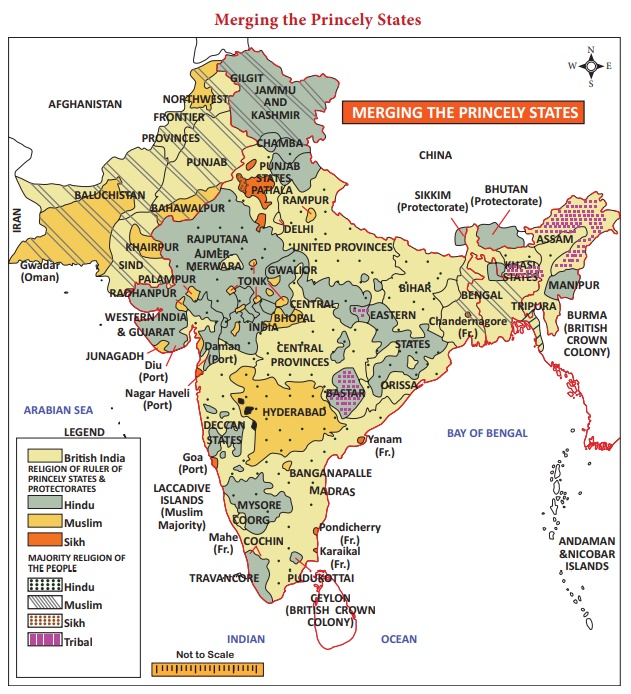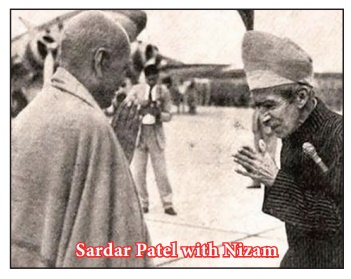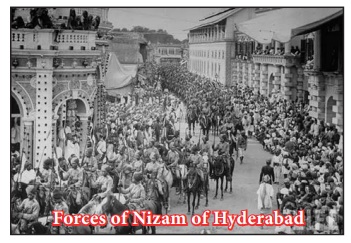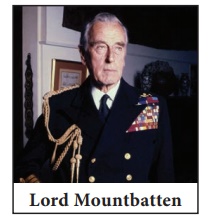Challenges of Nation Building | Political Science - Integration of Princely States | 12th Political Science : Chapter 7 : Challenges of Nation Building
Chapter: 12th Political Science : Chapter 7 : Challenges of Nation Building
Integration of Princely States
Challenges of Nation Building
Integration of Princely States
Emergence of Princely States in India
A ‘princely state’ or a ‘native
state’ is a political unit of a larger administrative province, which either is
ruled directly by monarchic lineage or serves as a subsidiary coalition with a
more powerful monarchic government. These smaller administrative pockets were
based on the political, cultural, lingual, and geographical landscape. In the
westerns and central India princely states came into existence with the entry
of Rajputs into the Indian sub-continent who migrated from Central Asia around
200 AD(CE). The word ‘Rajput’ means ‘sons of kings’. Hence, princely states
were established even before the Mughal and British colonial invasion. There
were a number of Non-Rajput princely states too some ruled by Nawabs and
Nijams, some ruled by native dynasties like Mysore, Travancore and Pudukottai.
All those monarchical states subordinated to the British India were termed as
Princely States. However, the word ‘princely’ was deliberately retained during
the British regime, to ascribe subordination of the rulers in the sub-continent
to the British Crown.
Attempts at Integrating Princely States
As mentioned earlier, the
princely states were fragmented administrative pockets and the subject of
integration of princely states in the phase preceding Indian independence has a
long history even before the Colonial invasion. Many dynasties attempted to integrate
the princely states starting from the Maghadan Kings, Bimbisara, and Ajatasatru
during Mauryans, Ashoka, Chandragupta and his son Samudragupta, all of them who
almost managed to bring many smaller kingdoms together, but consolidating under
one rule still remained a far cry. However, when the thirst for power, jealousy
and frequent disagreements among kingdoms led to resentment and disunity, it
paved way for Arab and Persian invasion, establishing the Moghul empire and
eventually conquering the northern part of pre-independent India.
Princely States under British Raj
a) Gun Salute System:
Therefore, by the time European
colonisation, i.e. the British, Portuguese, and French, started to take over,
the disunity worked in their favour to establish their presence, initially
through trade. Among the three, the British managed to institute sovereignty
under the crown of many princely states but not all. There were 565 princely
states in pre-independent India and, the ‘gun salute’ system under the British
rule was an open gesture to announce the level of affiliation of a princely
state to the British East India Company. Therefore, there were two kinds of
princely states: ‘Salute Princely States’ and ‘Non- Salute Princely States’.
b) Salute States
The ‘Salute States’ were States that had the
British East India presence, and there were around 117 to 120 salute states.
So, the heads, rulers, or princes of these states, were greeted with gun
salutes. The number of guns used to salute a particular head of a State
reflected the level of honour and prestige granted to a ruler. A 21-gun salute
was the highest honour granted to a ruler and rulers of lesser ranks received a
minimum of 9-gun salute. Some of the rulers who received the 21-gun salute
include:
v His Highness the Maharaja Scindia of
Gwalior
v His Highness the Maharaja Gaekwar of Baroda
v His Highness the Maharaja of Jammu and
Kashmir
v His Highness the Maharaja of Mysore
v His Exalted Highness the Nizam of Hyderabad
and Berar
Some of the rulers who received 9-gun salutes
include:
v The Nawab of Sachin
v The Maharaja of Patna
v The Maharana of Wadhwan
v The Nawab of Loharu
c) Non-salute States
Among the 565 Princely States, only 117 to 120 were
salute states, which implied there were many other States which were under the
British rule or British Raj were non-salute states. The reasons include:
a) Some were not acknowledged as gun salute states
b) Some princely states were considered of lower
prestige
c) Some princely states were obsolete but the rulers
were permitted to their royal entitlements and even received pensions
Princely States of India
During the pre-independence phase, many princely states enjoyed the patronage of the British rule and were not eager to part with their privileges when the integration of States were proposed. Some of the rulers were looking forward to establishing finally their own independent State, and assert their autonomy, post-independence. A unification of princely states meant the end of British rule, as well as the dissolving of the princely states, and provinces. In 1947, the unification process began amidst high politics, diplomatic negotiations and violence. The British Prime Minister, Clement Attlee, when addressing the House of Commons on 15th March 1946 acknowledged the fight for freedom and the lives lost towards the struggle for an independent nation. He also put forth the challenges that India would face given its complex cultural heritage. He said, “I am well aware, when I speak of India, that I speak of a country containing a congeries of races, religions and languages, and I know well all the difficulties thereby created. But those difficulties can only be overcome by Indians. We are very mindful of the rights of minorities and minorities should be able to live free from fear.”

Nevertheless, the process towards nation building
and negotiations to merge the States began in April 1947. Some of the problems
faced towards nation building were communal riots, partition, and refugee
crisis. Once India became independent, Sardar Vallabhai Patel took over as the
Deputy Prime Minister and Minister of Home Affairs and the merging of 565
princely states began. He along with VP Menon, his Secretary, who did the
groundwork as he was formerly an Indian civil servant, who had served the last
three British viceroys, made political integration possible. Sardar Patel and
VP Menon convinced the heads of the Princely States to cooperate by joining the
Indian Constituent Assembly. They were also promised that their personal assets
and possessions would not be taken over by the government. Many princely states
consented, except Junagadh, Kashmir, and Hyderabad who wanted to remain
independent.
Junagadh
The Nawab of Junagadh, or his Dewan,
Shah Nawaz Bhutto, father of Zulfikar Ali Bhutto, who later went on to become
the President of Pakistan, both rejected the autocratic rule. Three States
surrounding Junagadh, chose to be part of India, and the fourth side it is
covered by the Arabian sea. The majority of the population were non-Muslims,
nonetheless Dewan Bhutto joined Pakistan on 15th August 1947. People started to
protest and insisted the Dewan to request the Indian government to take over
the administration. By then, the Dewan had already flown with his family to Karachi,
the then capital of Pakistan, along with the State’s treasure.
Hyderabad
The Nizam of Hyderabad was yet
another ruler who headed a State with predominantly non-Muslim population.
However, Hyderabad was in the heart of India and anticipated independent
status. Lord Mountbatten informed that it cannot become a Dominion. A
‘dominion’ meant a self-governing nation in the British Commonwealth. In
addition, it became known that the Nizam became a prisoner of a communal organisation,
Ittehad-ul-Musilmeen led by Kasim Razvi, whose armed volunteers were called
‘razakars’. The Nizam had initially encouraged them but later lost control over
their activities. In addition, the Nizam had also lifted the ban on imposed on
Communist Party in 1943. The collaborated activities of the Razakars and the
Communist party resulted in violence. Trains passing through the State were
attacked. With barely any help from the Nizam, the Indian troops were sent into
the State in September 1948. The Nizam was offered a large portion of wealth
and privileges once he declared that Hyderabad will be part of India.

As a result of the Communist anti-landlord uprising
in Telangana region of Hyderabad was the Bhoodan movement, meaning the ‘gifting
of land’. The Bhoodan movement was initiated by Vinobha Bhave, a disciple of
Mahatma Gandhi, who promoted the voluntary redistribution of land favouring the
landless.
Jodhpur
Initially, Jodhpur had expressed
their desire to join India, but when Maharaja Hanvant Singh took over as the
ruler, he preferred joining Pakistan instead of India. Muhammed Ali Jinnah,
allegedly offered Maharaja Hanvant Singh, free access to Karachi port, and arms
manufacturing and importing them. Seeing the threat posed at the border, Patel
made a better offer to Maharaja Hanvant Singh, by permitting importing of arms,
rail connectivity between Jodhpur and Kathiawar and supply of grains to farmers
during a famine. Fearing communal violence, because the population of Jodhpur
were predominantly Hindus, Maharaja Hanvant Singh conceded to join India.

Kashmir
The only Princely State left was
Kashmir, which had a Hindu ruler Maharaja Hari Singh. Since the majority of the
population were Muslims, Pakistan assumed Kashmir belonged to them. Hence, on
August 15th 1947, ruler Hari Singh proposed a standstill agreement allowing the
mobility of people and goods. Pakistan consented but India refused, which
provoked Pakistan to violate the Standstill agreement. When Hari Singh wanted
military assistance from India, Lord Mountbatten clarified that under the
International law, India can send her military troops only if the State signs
the instrument of accession, which Hari Singh promptly did, on 26th October
1954. On the very next day, 27th October 1954, the army was sent to Srinagar,
ousting Pakistan from the Kashmir valley

Activity
Identify the prominent personalities
and discuss their contributions to our nation with your friend.
Related Topics